Intraday trading, a strategy that has garnered interest for its potential for swift gains, involves purchasing and liquidating financial instruments within the same market day. Unlike long-term investment strategies, intraday trading leverages minor price fluctuations within brief periods. This introduction delves into what intraday trading entails, how it distinguishes itself from other market strategies, its allure, and the inherent risks involved.
What is Day Trading?
Day trading is the practice of opening and closing positions in stocks, forex, commodities, or other financial markets within a single day, with the aim of profiting from short-term price fluctuations. Participants typically close all positions before the market closes to avoid unanticipated risks from overnight price changes.
How Day Trading Differs from Other Trading Styles
Time Frame
The most distinguishing feature of day trading is its short time frame. While swing traders may hold positions for days to weeks and position traders for months to years, day traders operate within the confines of a single day.
Capital and Leverage
Day trading often requires substantial capital to capitalize on minor price fluctuations, and many day traders utilize leverage to enhance their investment capital. This can increase potential gains but also magnifies potential losses.
Analysis and Tools
Day traders rely heavily on technical analysis and real-time trading tools to make quick, informed decisions. The use of charts, technical indicators, and trading platforms that offer near-instantaneous execution is crucial in the fast-paced environment of day trading.
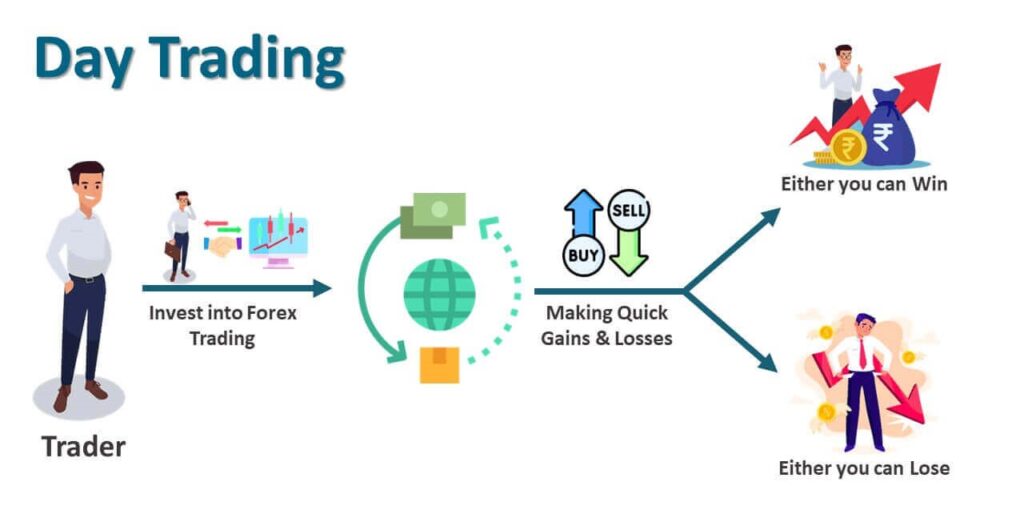
The Appeal of Day Trading
Potential for Quick Profits
The primary appeal of day trading is the potential for quick profits. Traders are attracted to the idea of earning significant returns in a short period, leveraging small price movements for gain.
Excitement and Challenge
Day trading is dynamic and fast-paced, offering a thrilling challenge for those who enjoy active engagement with the markets. The need for quick thinking and decision-making can be exhilarating.
Flexibility
Day trading offers flexibility, allowing traders to operate on their own schedule, particularly in markets like forex that are open 24 hours. Many find the prospect of being able to trade full-time or as a supplement to their income appealing.
Risks Involved in Day Trading
Market Volatility
Day trading involves capitalizing on volatility, but unexpected market movements can result in substantial losses, especially when leveraging positions.
Psychological Pressure
The fast-paced nature of day trading can lead to significant psychological stress, with the pressure to make quick decisions potentially leading to errors in judgment.
Financial Risk
The potential for rapid losses, especially when using leverage, means day traders must have a clear risk management strategy. Without it, traders can quickly deplete their trading capital.
Learning Curve
Successful day trading requires a deep understanding of markets, technical analysis, and a developed skill set for executing trades effectively. The learning curve can be steep, and the path to profitability is often paved with losses.
Essential Tools for Day Traders
Day trading, with its rapid pace and need for precision, demands a well-equipped arsenal of tools and technology. Successful day traders rely on a variety of resources to make informed, timely decisions and execute transactions efficiently. From advanced trading platforms and charting software to real-time news feeds, each tool plays a critical role in navigating the markets. Here’s an overview of the essential tools needed for effective day trading.
Trading Platforms
The heart of a day trader’s toolkit is the trading platform. It’s not just a medium for placing trades; it’s an integrated environment offering market data, execution speed, and analytical tools.
- Key Features: Look for platforms that offer low-latency trade execution, real-time quotes, advanced order types, and seamless integration with brokerage accounts. Customizability and reliability are also paramount.
- Examples: MetaTrader 4/5, NinjaTrader, and Thinkorswim are popular among day traders for their comprehensive features and robust performance.
Charting Software
Charting software provides the visual representation of market data essential for technical analysis. The best charting tools offer a wide range of indicators, drawing tools, and customization options.
- Key Features: Effective charting software should allow for easy manipulation of data with multiple time frame views, indicators (both standard and custom), and back-testing capabilities for strategy evaluation.
- Examples: TradingView and StockCharts are favored for their extensive charting capabilities and user-friendly interfaces.
News Feeds
In day trading, where seconds can mean the difference between profit and loss, having access to real-time news is crucial. Economic events, earnings reports, and geopolitical developments can all cause significant market movements.
- Key Features: Look for news services that provide real-time, global coverage with alerts and filters to tailor the news stream to your specific interests or the markets you trade.
- Examples: Bloomberg, Reuters, and CNBC are reputable sources offering timely financial news. Specialized services like Benzinga Pro are designed with traders in mind, providing fast, actionable information.
Market Analysis Tools
Beyond basic charting, advanced market analysis tools can offer deeper insights into market trends and behavior.
- Key Features: Tools that provide market sentiment analysis, volume and volatility indicators, and heat maps can give day traders an edge in understanding market dynamics.
- Examples: Tools like MarketSmith for in-depth stock analysis or the volume and order flow analysis features in platforms like NinjaTrader can be invaluable.
Economic Calendars
Staying ahead of market-moving events is easier with a reliable economic calendar. These calendars list upcoming financial events, such as central bank meetings, economic data releases, and earnings announcements.
- Key Features: An effective economic calendar should be customizable to your time zone and the markets you trade, with alerts for upcoming events.
- Examples: Many financial websites and trading platforms offer integrated economic calendars. Forex Factory and Investing.com provide comprehensive economic calendars favored by many day traders.
Risk Management Tools
Effective risk management is critical for day trading success. Tools that help manage and mitigate risk can safeguard profits and limit losses.
- Key Features: Automated stop-loss and take-profit orders, position size calculators, and risk-reward ratio analyzers are essential for managing trade risk.
- Examples: Most advanced trading platforms include integrated risk management tools, while standalone options like the Risk Calculator for MetaTrader can further enhance risk analysis.

Choosing a Broker for Day Trading
In the fast-paced world of day transactions, selecting the right broker is as crucial as developing a solid transaction strategy. The broker is your gateway to the markets, and the services they offer can significantly impact your transaction efficiency and profitability. For day traders, certain broker attributes are non-negotiable: low transaction fees, rapid execution speeds, a reliable transaction platform, and exceptional customer service. Here’s what to look for when choosing a broker for day transactions.
Low Transaction Fees
Day traders execute numerous trades daily, and even small fees can accumulate, eating into profits.
- What to Look For: Competitive spreads for forex traders, low commissions on stocks and ETFs, and minimal to no account maintenance fees. Some brokers offer tiered pricing to benefit high-volume traders.
- Tip: While low fees are important, they shouldn’t be the sole criterion. Balance cost with the quality of the broker’s platform and services.
Fast Execution
In day trading, where markets move swiftly, the speed of order execution can make a significant difference in the outcome of a trade.
- What to Look For: A broker that offers fast, reliable order execution. This ensures that your trades are executed at the best possible prices, even in rapidly changing markets.
- Tip: Test the broker’s execution speed using a demo account or by starting with small trades on a live account.
Reliable Trading Platform
A robust, intuitive trading platform is the backbone of successful day trading. It should support quick decision-making and the ability to act on market movements without hesitation.
- What to Look For: A platform that is stable (minimal downtime), user-friendly, and equipped with advanced charting tools, real-time data, and customizable indicators.
- Tip: Ensure the platform offers mobile trading capabilities, allowing you to monitor and execute trades on the go.
Good Customer Service
When trading with high stakes, having access to prompt and knowledgeable customer support can be invaluable, especially in resolving trading or account issues that may arise.
- What to Look For: Look for brokers that provide 24-hour customer service with multiple channels of support (phone, email, live chat) and a reputation for quick, helpful responses.
- Tip: Test the customer service response time and quality before committing to a broker by asking a few technical and account-related questions.
Additional Considerations
- Regulation and Security: Ensure the broker is regulated by reputable financial authorities, offering security measures for your funds and personal data.
- Market Access: Consider brokers that offer access to a wide range of markets and trading instruments, providing flexibility in your day trading activities.
- Educational Resources: Access to educational materials, webinars, and market analysis can be beneficial, especially for developing traders.
- Trading Community and Networking: Some brokers have active trading communities where you can exchange ideas and strategies with fellow traders.
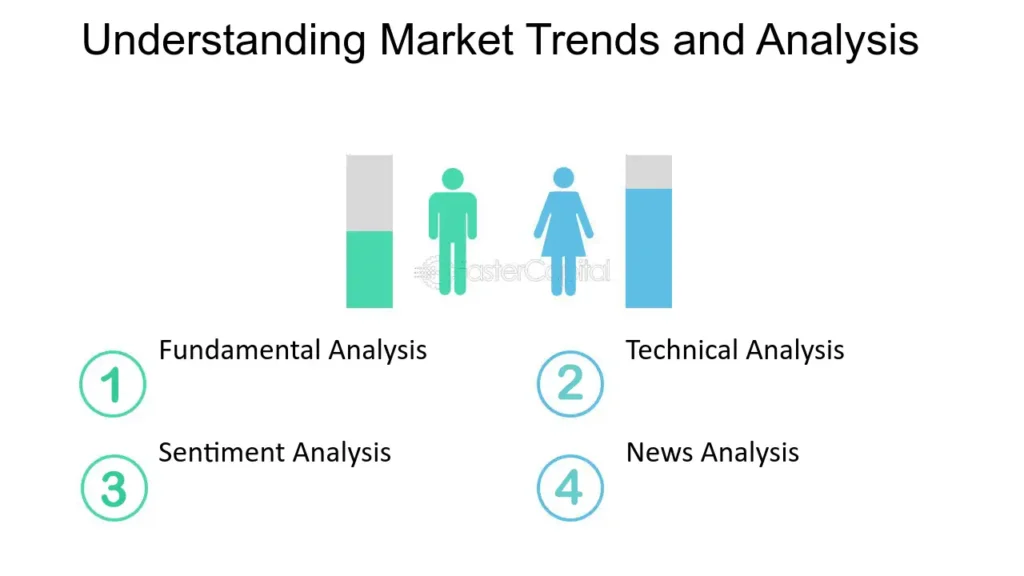
Understanding Market Analysis in Day Trading
Market analysis is indispensable in day trading, providing traders with the insights needed to make informed decisions swiftly. It encompasses two main approaches: technical analysis, which focuses on price movements and patterns, and fundamental analysis, which considers economic indicators and company-specific news. Understanding how to leverage both types of analysis can significantly enhance a day trader’s ability to spot opportunities and execute profitable trades.
Technical Analysis
Technical analysis is the cornerstone of day trading, relying on historical price data and volume to forecast future market movements. This method assumes that all known information is already reflected in prices, and therefore, by studying price patterns and market trends, traders can predict future price movements.
Charts
Charts are the primary tool for technical analysis, offering a visual representation of a market’s price movements over time. Different chart types—like line, bar, and candlestick charts—provide various perspectives on market data, helping traders identify trends, support and resistance levels, and potential reversal points.
Patterns
Technical analysts pay close attention to chart patterns, which are formations created by the price movements of a security. Patterns such as head and shoulders, double tops and bottoms, and triangles can signal future price movements, offering traders clues about potential entry and exit points.
Indicators
Technical indicators are mathematical calculations based on a security’s price and/or volume. They help traders evaluate market conditions and forecast future price movements. Popular indicators include Moving Averages (MA), Relative Strength Index (RSI), and Moving Average Convergence Divergence (MACD). Each serves different purposes, such as identifying trends, momentum, and overbought or oversold conditions.
Fundamental Analysis in Day Trading
While day traders primarily rely on technical analysis due to the short-term nature of their trades, fundamental analysis can still play a crucial role, especially in strategies that align with economic releases or company-specific events.
Economic Indicators
Day traders might adjust their strategies around the time of major economic announcements—such as interest rate decisions, employment reports, and GDP figures—since these can cause significant volatility in the markets. Understanding the potential impact of these indicators can provide a competitive edge.
Company-Specific News
For those trading stocks or CFDs on company shares, news releases such as earnings reports, mergers and acquisitions, and other corporate events can dramatically affect a stock’s price. Keeping abreast of such news is crucial for day traders to capitalize on or hedge against sudden market movements.

The Synergy of Technical and Fundamental Analysis
Incorporating both technical and fundamental analysis allows day traders to gain a more holistic view of the market. Technical analysis can guide entry and exit points, while fundamental analysis can offer insights into the broader market sentiment and potential catalysts for price movements. By synthesizing information from both approaches, traders can refine their strategies and improve decision-making.
Developing a Day Trading Strategy
In the dynamic realm of financial markets, selecting an appropriate broker is just as crucial as crafting a robust strategy. This broker serves as your access point to market operations, with their offerings greatly influencing your efficiency and success. For those focused on short-term transactions, specific attributes of a broker are indispensable: minimal transaction costs, swift order executions, a dependable market interface, and superior support. Consider these factors carefully to ensure your choice enhances your market endeavors.
Creating a Trading Strategy
Define Your Goals and Risk Tolerance
Begin by establishing your objectives for day activity and assessing your tolerance for risk. Consider whether your primary goal is to generate consistent income, achieve capital growth, or a combination of both. Determine the portion of your activity capital you’re prepared to risk in a single transaction. Identifying your aims and risk capacity is crucial for crafting a plan tailored to your needs.
Choose Your Market
Different markets come with their own set of characteristics, such as volatility, volume, and market hours. It’s important to choose a market that aligns with your investment style and objectives. For example, the forex market is known for its high liquidity and the ability to engage around the clock, offering investors flexibility in their schedules. On the other hand, stock markets can present opportunities tied to specific company news, appealing to those looking to invest based on fundamental analysis.
Identify Trading Opportunities
Use technical analysis to identify potential trading opportunities. This includes understanding chart patterns, indicators, and price action. Fundamental analysis can also play a role, especially for strategies aligned with economic releases or news events.
Set Entry and Exit Points
Define specific criteria for entering and exiting trades based on your analysis. This includes setting stop-loss orders to manage risk and take-profit levels to secure gains.
Manage Your Risk
Implement risk management techniques, such as only risking a small percentage of your account on a single trade and using proper position sizing, to protect your trading capital.
Test Your Strategy
Before going live, test your strategy using historical data or a demo account. This practice, known as backtesting, allows you to refine your strategy without risking real money.
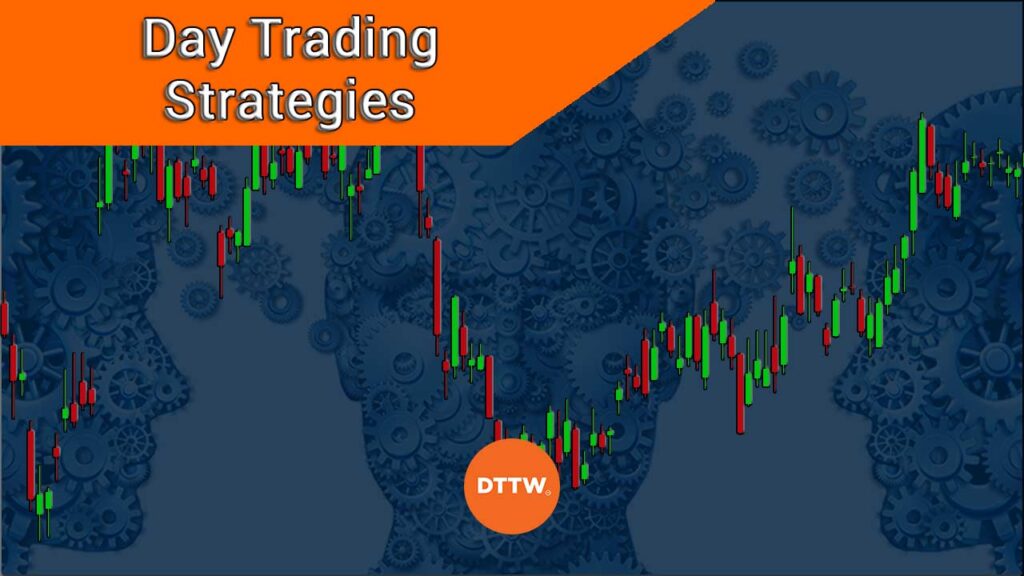
Common Day Trading Strategies
Scalping
Scalping involves making dozens or even hundreds of trades in a single day, trying to capture small price movements. Scalpers aim for volume over individual trade size, focusing on markets with high liquidity.
Momentum Trading
Momentum traders look for securities moving significantly in one direction on high volume and try to ride the momentum to profit. They use indicators like moving averages and MACD to identify potential momentum opportunities.
Swing Trading
Although typically more of a short-term strategy extending beyond a single day, swing trading can be adapted for day trading by focusing on trades that exploit the intra-day price swings. Swing traders use a mix of technical and fundamental analysis to choose their trades.
Testing and Refining Your Strategy
Continuous testing and refinement are key to maintaining a successful day trading strategy. Market conditions change, and flexibility is crucial for adapting your strategy to remain effective. Regularly review your trading journal, analyze your wins and losses, and adjust your strategy as needed.
Risk Management in Day Trading
Risk management is fundamental to the success of day activities. Given the fast-paced and volatile nature of day markets, implementing effective risk management techniques is essential to protect capital and ensure sustainability in these activities. Key strategies include setting stop-loss orders, controlling position size, and limiting daily losses. Let’s delve into these techniques and how they can be effectively applied in day activities.
Setting Stop-Loss Orders
A stop-loss order is an automatic order placed with your broker to sell a security when it reaches a certain price, thus limiting your potential loss on a position.
- Application: Determine your stop-loss level based on your risk tolerance and the volatility of the security you are trading. The key is to set it at a level that allows the market enough room to fluctuate while protecting you from substantial losses.
- Benefits: Stop-loss orders help remove the emotional decision-making involved in closing a losing trade, enforcing discipline, and helping to preserve capital.
Controlling Position Size
Position sizing is the process of determining how much of your capital to allocate to a single trade, based on the risk involved.
- Calculation: One common method is to risk only a small percentage of your total trading capital on any single trade (e.g., 1-2%). This approach ensures that even a series of losses won’t significantly impact your overall capital.
- Considerations: Your position size should also take into account the stop-loss level you’ve set. Wider stop-losses might require smaller positions to maintain a consistent risk level across trades.
Limiting Daily Losses
Setting a daily loss limit is a discipline that can protect traders from the emotional and financial spiral that can result from consecutive losing trades.
- Strategy: Determine a maximum daily loss you are comfortable with (e.g., a percentage of your trading capital) and strictly adhere to it. Once you hit this limit, stop trading for the day.
- Psychological Benefit: This technique not only preserves capital but also helps maintain a healthy psychological state, preventing “revenge trading” or the urge to make back losses immediately, often at higher risk.
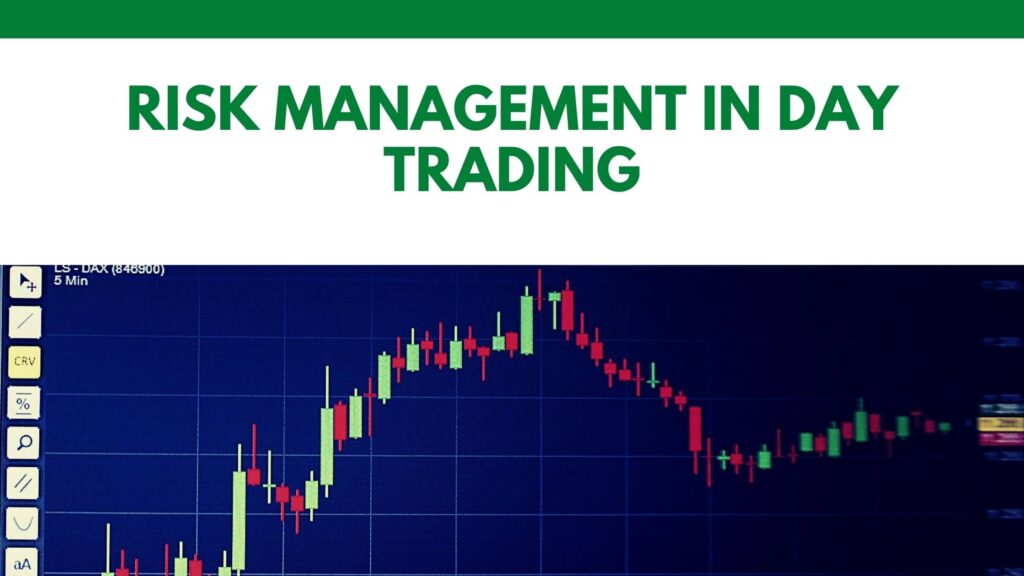
Additional Risk Management Considerations
Regular Review and Adjustment
- Regularly review your trading performance to assess the effectiveness of your risk management strategies. Be prepared to adjust your techniques based on changing market conditions or shifts in your trading performance.
Diversification
- While diversification is more challenging to achieve within the constraints of day trading, try to spread your trades across different sectors or instruments to reduce risk.
Education and Continuous Learning
- Stay informed about market trends and continually educate yourself on trading strategies and risk management practices. The more knowledgeable you are, the better equipped you’ll be to manage risks effectively.
The Psychological Aspect of Day Trading
Day trading, characterized by its fast pace and high pressure, not only tests a trader’s skill and strategy but also their psychological resilience. The volatility of markets can evoke strong emotions, making emotional control and stress management pivotal for success. Understanding the psychological challenges of day trading and adopting strategies for discipline and patience can significantly enhance a trader’s performance.
Managing Emotions and Stress
Recognize Emotional Triggers
Identifying what triggers emotional responses, such as fear or greed, is the first step in managing them. Common triggers include the fear of missing out (FOMO) on profitable trades or the desire to recover losses quickly.
Develop Emotional Resilience
Building resilience involves practicing mindfulness and emotional detachment from trades. Viewing trading as a business and focusing on process over outcomes helps maintain objectivity.
Stress Reduction Techniques
Day trading can be stressful, leading to decision fatigue and burnout. Incorporating stress reduction techniques such as regular breaks, physical exercise, and meditation can help maintain a clear mind and reduce the impact of stress on decision-making.
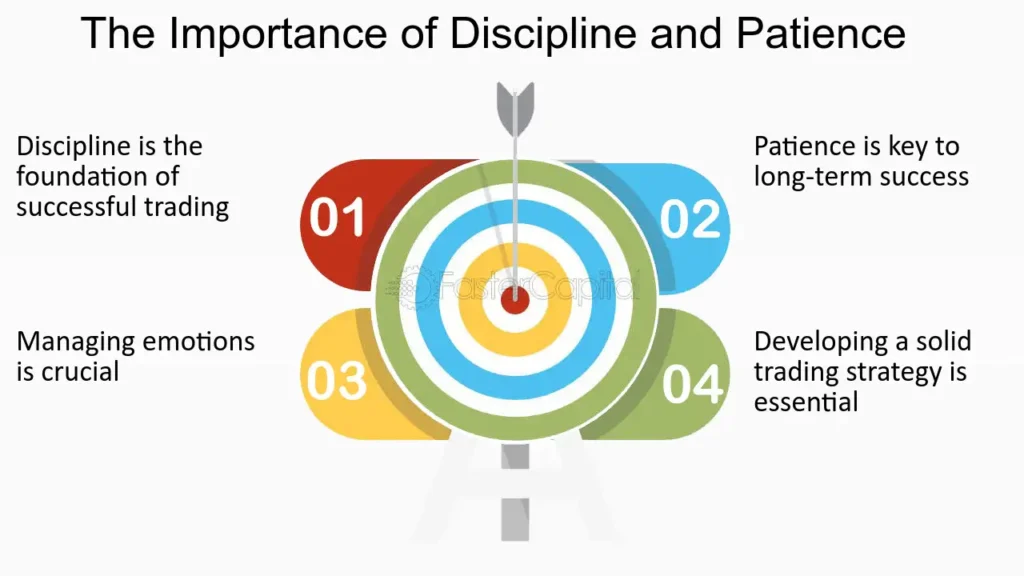
The Importance of Discipline and Patience
Discipline: The Foundation of Successful Trading
Discipline involves adhering strictly to your trading plan, regardless of emotions or market hype. It’s about making informed decisions based on analysis and strategy, rather than impulsive reactions to market movements.
- Enforce Discipline: Setting clear rules for when to enter and exit trades, how much to risk, and adhering to these rules can enforce discipline. Utilizing tools like automatic stop-loss orders can help maintain discipline by automating risk management.
Patience: Timing is Everything
Patience is critical in waiting for the right trading opportunities and not forcing trades. It’s about recognizing that not every market condition is favorable for your strategy and being willing to wait for the conditions that are.
- Cultivating Patience: Practice patience by setting realistic expectations and understanding that profitable trading is about quality over quantity. Monitor the markets and your chosen indicators closely, but resist the urge to trade on every perceived opportunity.
Psychological Tools for Traders
- Trading Journal: Keeping a detailed journal of trades, including emotional states and outcomes, can provide insights into emotional patterns and triggers, allowing for better emotional management.
- Continuous Learning: Enhancing your trading knowledge and skills can boost confidence, reducing stress and emotional volatility.
- Support Networks: Engaging with a community of traders can provide emotional support and valuable perspectives, reducing the sense of isolation that can accompany day trading.
Practicing with a Demo Account in Day Trading
Before diving into the high-stakes world of day speculating with real money, practicing with a demo account offers invaluable experience without any of the financial risks. Demo accounts, provided by most online speculation platforms, simulate real speculation environments with virtual funds, allowing speculators to hone their skills, test strategies, and build confidence. Here’s why using demo accounts is a critical step for anyone considering day speculating.
Benefits of Using Demo Accounts
Risk-Free Learning Environment
Demo accounts allow you to familiarize yourself with trading platforms and the mechanics of placing trades without risking real capital. This risk-free environment is ideal for beginners to understand market movements and practice executing trades.
Strategy Testing and Refinement
One of the primary benefits of demo accounts is the ability to test and refine trading strategies. Traders can experiment with different approaches, indicators, and time frames to see what works best for them without the fear of losing money.
Understanding Market Volatility
Day trading often involves capitalizing on small price movements within very short time frames. Demo accounts provide a practical understanding of market volatility and how it affects trades, helping traders learn to navigate fast-paced market changes.
Emotional Preparedness
Trading with virtual money helps in understanding the emotional challenges involved in transacting, such as dealing with loss, managing greed, and maintaining discipline. Although the emotional intensity might differ with real money on the line, demo transactions are a useful step toward emotional preparedness.
Familiarization with Order Types
Demo trading offers the opportunity to become proficient with various order types—market orders, limit orders, stop-loss orders, and others. Understanding these tools is crucial for effective risk management and strategy execution in day trading.
Tips for Effective Demo Trading
- Treat It Like Real Trading: To maximize the benefit of a demo account, treat the virtual money as if it were real. This approach helps develop discipline and realistic trading habits.
- Set Realistic Goals: Establish goals for your demo trading practice, such as achieving a certain success rate with your trades or consistently implementing your trading strategy over a specific period.
- Keep a Trading Journal: Document your demo trades, including the strategy used, the outcome, and any lessons learned. This journal can be a valuable tool for evaluating your progress and identifying areas for improvement.
- Transition Gradually to Live Markets: When you feel confident in your market abilities and strategy performance in the demo environment, transition to live markets gradually. Consider starting with a small amount of capital to manage the emotional transition from demo to real market activity.
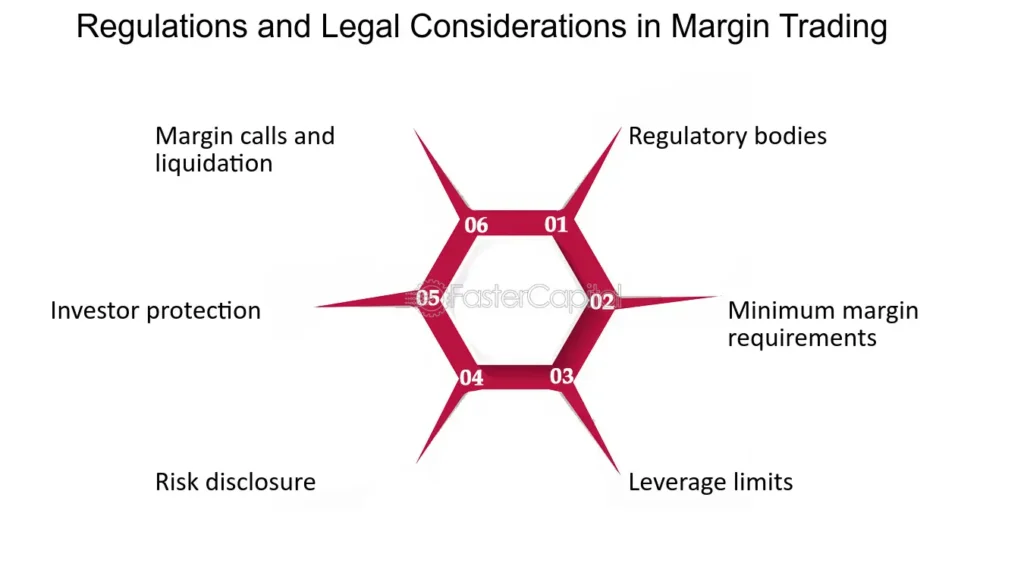
Legal and Regulatory Considerations in Day Trading
Day trading is not just about analyzing charts and executing transactions; it’s also crucial to navigate the legal and regulatory framework that governs market activities. This framework ensures market integrity and protects individual participants. Among the most notable regulations is the Pattern Day Trader (PDT) rule, which applies to U.S. stock markets. Understanding these rules and regulations is essential for compliance and for making informed decisions in the marketplace.
Understanding the Pattern Day Trader Rule
The PDT rule is enforced by the Financial Industry Regulatory Authority (FINRA) and applies to U.S. brokerage accounts. It is designed to discourage excessive trading in customer accounts.
Criteria for Pattern Day Traders
A trader is considered a “Pattern Day Trader” if they execute four or more day trades within a rolling five-business-day period, and these trades represent more than 6% of the trader’s total trading activity in that same five-day period.
Requirements for Pattern Day Traders
Once designated a PDT, traders must maintain a minimum account balance of $25,000 in their brokerage account. This balance may be a combination of cash and eligible securities. If the account falls below this threshold, the trader will not be allowed to day trade until the balance is restored.
Consequences of Violating the PDT Rule
If a trader violates the PDT rule, their brokerage may subject their account to restrictions, such as being limited to closing trades only until the account is brought into compliance with the rule. In some cases, brokerages may give a one-time margin call or day trading buying power call, but repeated offenses can lead to more severe penalties.
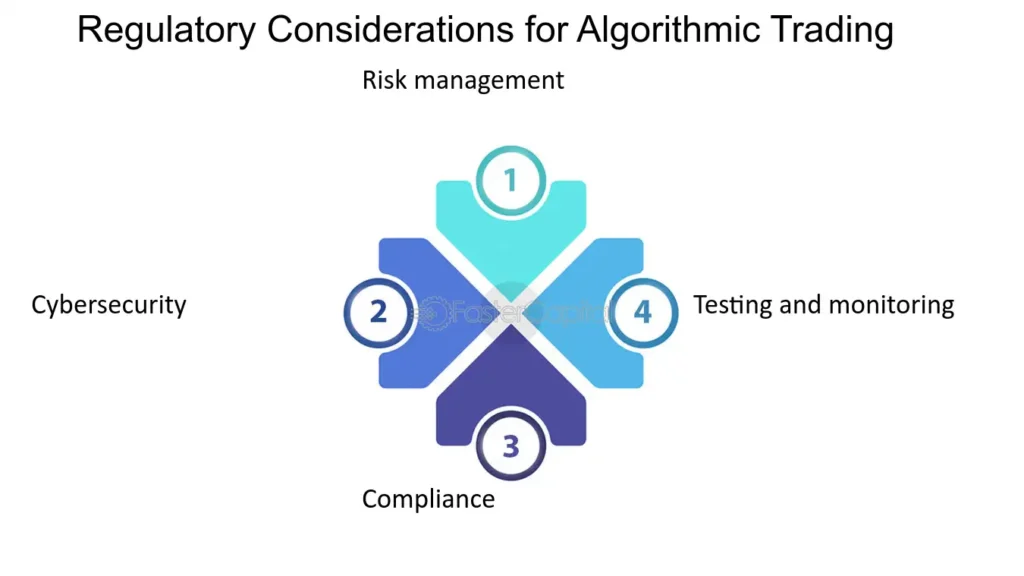
Additional Regulatory Considerations
Margin Requirements
Day traders using margin accounts must be aware of specific margin requirements, such as the SEC’s requirement that day traders maintain a 25% minimum margin. Understanding how margin works and the implications of trading on margin is crucial for effective risk management.
Reporting Requirements
Day traders must report their earnings accurately for tax purposes. The complexity of tax obligations can vary based on trading activity, the instruments traded, and the trader’s jurisdiction.
International Regulations
Traders outside the U.S. should familiarize themselves with the regulations applicable in their country or the region they are trading in. Many countries have their own versions of the PDT rule or other regulations impacting day trading.
Navigating Legal and Regulatory Challenges
Stay Informed
Regulatory environments are subject to change, so staying informed about current and upcoming regulations is vital. This can involve regular consultations with legal advisors or using resources provided by regulatory bodies.
Choose a Reputable Broker
A reputable broker will not only ensure compliance with trading regulations but can also provide valuable guidance on staying within legal boundaries. Many brokers offer educational resources and tools to help manage day trading activities in accordance with regulatory requirements.
Record-Keeping
Maintaining detailed records of your trading activities can help in managing regulatory obligations, especially for tax purposes. It also aids in disputing any inaccuracies or misunderstandings regarding your trading activities.
How to Improve Your Day Trading Skills
Improving your day trading skills is a continuous process that requires dedication, discipline, and a commitment to learning. The dynamic nature of the financial markets means that there is always something new to learn or a new strategy to test. Here are some effective ways to enhance your day trading capabilities:
Engage in Continuous Learning
The financial markets are constantly evolving, and so should your understanding of them. Engaging in continuous education ensures that you stay updated on the latest trading strategies, tools, and market trends.
- Educational Resources: Utilize books, online courses, webinars, and financial news websites to broaden your knowledge. Focus on both the technical aspects of trading and the psychological aspects.
- Stay Updated: Follow market news and trends to understand the factors that drive market movements. This will help you make more informed trading decisions.
Practice with Demo Accounts
Demo accounts provide a risk-free environment to practice your trading strategies, test new ideas, and get familiar with the trading platform without risking real money.
- Simulate Real Trading Conditions: Use demo accounts to simulate trading under real market conditions. This helps in refining strategies and improving decision-making skills.
- Experiment: Take advantage of the risk-free nature of demo accounts to experiment with different strategies and instruments. This could lead to discovering approaches that align well with your trading style.
Analyze Your Trades
Regular analysis of your trades is crucial for identifying what works and what doesn’t. This introspection helps in honing your strategies and avoiding past mistakes.
- Keep a Trading Journal: Record details of all your trades, including the rationale behind each decision, the outcomes, and any lessons learned. Over time, patterns will emerge that can guide your future trading decisions.
- Review and Reflect: Set aside time regularly to review your trading journal. Look for successful trades to replicate and unsuccessful ones to learn from. Reflecting on your emotional state during each trade can also provide insights into how emotions affect your trading.
Follow Market Trends
Staying informed about current market trends and economic events allows you to anticipate market movements and align your trading strategies accordingly.
- Economic Calendars: Use economic calendars to track important events that could influence the markets, such as central bank announcements, earnings reports, and economic indicators.
- Financial News: Subscribe to financial news services for up-to-date information on market movements. Real-time news can provide trading opportunities and help you manage risks more effectively.
Cultivate Discipline and Patience
Discipline and patience are key virtues in day trading. They help in adhering to your investment plan, avoiding impulsive decisions, and waiting for the right market opportunities.
- Stick to Your Investment Plan: Adhere to the entry and exit criteria you’ve set in your investment plan. This discipline helps in maintaining consistency in your investment approach.
- Practice Patience: Be patient in waiting for the right trading setups to occur. Not every day will present viable trading opportunities, and overtrading can lead to unnecessary losses.

FAQs:
- What Is Day Trading?
- Day trading involves buying and selling financial instruments within the same trading day to capitalize on short-term price movements.
- What Do I Need to Start Day Trading?
- A computer with a reliable internet connection, a trading platform, starting capital, and access to real-time market data.
- How Do I Choose a Broker for Day Trading?
- Look for brokers with competitive fees, rapid trade execution, robust trading platforms, and excellent customer support.
- Can I Make a Living Day Trading?
- While some traders make a living from day trading, it requires significant skill, discipline, and risk management. Success is not guaranteed.
- What Are the Most Common Day Trading Strategies?
- Popular strategies include scalping (profiting from small price changes), momentum trading (buying on news releases and strong trends), and swing trading (trading on price “swings” within a trend).
- How Important Is Risk Management in Day Trading?
- Risk management is critical to protecting your capital. Effective strategies include using stop-loss orders and never risking more than a small percentage of your account on a single trade.
- What Psychological Traits Are Important for Day Traders?
- Successful day traders often exhibit traits like discipline, decisiveness, patience, and the ability to manage stress and emotions.
- Should Beginners Use Demo Accounts?
- Yes, demo accounts offer a risk-free way to practice trading strategies and get familiar with the trading platform without risking real money.
- What Are the Legal and Regulatory Considerations for Day Trading?
- Regulations vary by country, but may include minimum capital requirements and restrictions on the number of trades that can be made without being classified as a “pattern day trader.”
- How Can I Improve My Day Trading Skills?
- Continuous learning, practicing with demo accounts, following market trends, and analyzing your trades to learn from successes and mistakes.

